Among the possible causes of winters with extreme snow amount at high altitudes in few sectors of the Southern Alps, there are Arctic Amplification and modification of the Rossby waves with the increasingly warm sea surface. In the last 15 years, this has led to a slight increase in the volume of several small glaciers of the Julian Alps in the South East. This trend could persist in the next future with extreme snowfalls in the Alps leading to glacier stability in few marginal alpine sectors where precipitation is already high. The influence of the Atlantic Multidecadal Oscillation (AMO) modulated the glacial evolution of the Alps in the past.

The Cryosphere is declining at an accelerated rate. Today glaciers lose annually just about 31% more ice and snow than they did 15 years ago. This result comes after a long record of satellite measurements of all mountain glaciers in the world.
Globally, glaciologists and climatologists blame human-caused global warming. Glaciers in Alaska are among the ones with the highest melt rates on the planet. Alaskan glaciers melt 100 times faster than previously thought and the Columbia glacier retreats roughly 35 m (115 feet) every year.

Fast sea level rise is one of the most important issues related to global warming. Shrinking glaciers and ice sheets on continents mean the sea level rises. Thermal expansion occurring when water is heated increases its volume and this is another contributor to sea-level rise. Both ice melt and thermal expansion are the results of global average temperature rise on land and sea.
Besides Antarctica, the Greenland ice sheet represents the second largest continental ice body. Its mass has rapidly declined in the last decades owing to iceberg calving and surface melting.
In the video below credits NASA and JPL/Caltech satellite data indicate that between 2002 and 2020, Greenland shed an average of 279 billion metric tons of ice per year, adding to the global sea-level rise.
The European Alps represent one of the world’s areas with the largest glacier loss. This is mainly due to longer and warmer summers which triggered increased melting. Between 1850 and 1975 glaciers in the European Alps lost about half of their volume. Another 25% of the remaining amount melted between 1975 and 2000 and 10-15% more in the first 5 years of the century.
The longest alpine valley glacier, part of the Unesco World Heritage Site, is the Great Aletsch glacier. This glacier is around 80 square km in size, up to 800 meters deep, and over 20 km long. It contains over a fifth of the total ice volume in the Swiss Alps. After slowly retreating since 1870, it lost 32% of its mass and retreated by about 8.5 km in the last 30 years.
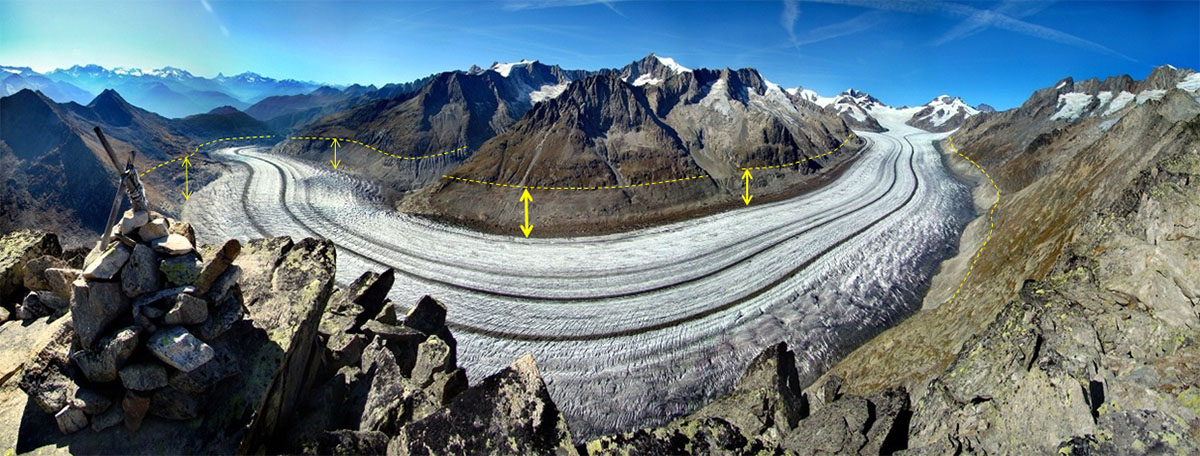
Figure: Image of the Aletsch glacier modifief from the original available at https://www.aletscharena.ch
ASSESSING GLACIER’S HEALTH, THE WORK OF GLACIOLOGISTS
Glaciologists investigate Glacier’s health through iterated surface mass balance measurements. Mass balance of a glacier is the difference between the snow accumulated in the previous winter and the ice and snow melted through the ablation season.
If summer melting overcomes what is gained from the previous winter, this means the glacier mass balance is negative and the glacier recedes. On the contrary, If the mass of snow accumulated on glaciers exceeds the mass of ice and snow lost during the summer the glacier is therefore in a ‘healthy’ state.
In this case, mass balance is positive and the glacier expands in size and volume advancing. Glaciers losing and gaining the same amount of ice and snow are though in equilibrium, still ‘healthy’, and will neither recede nor advance. Such mass differences are generally given in meters of water equivalent (w.e.).
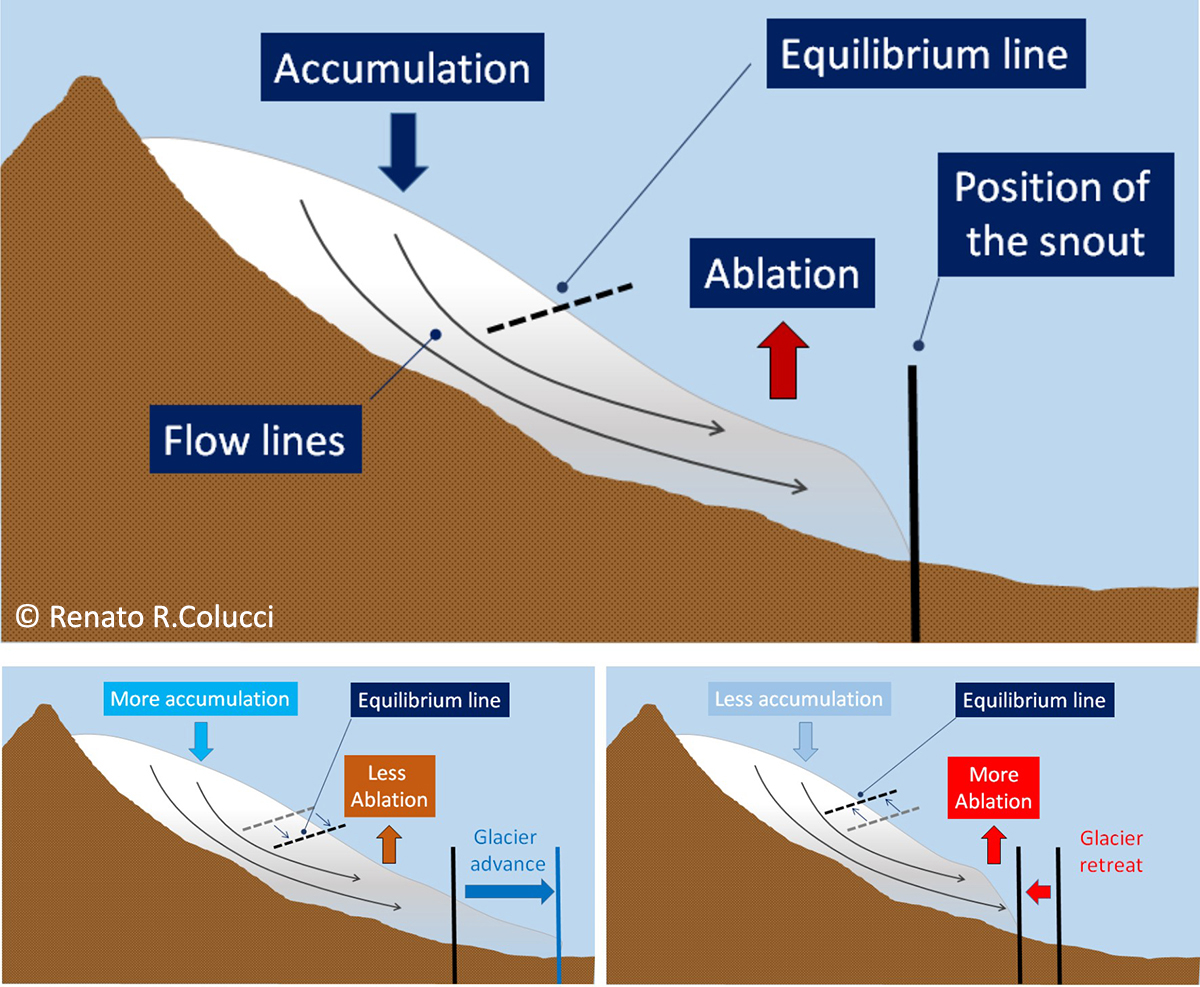
There should always be a glacier sector at a certain elevation where the annual mass balance is null. This altitude is the Equilibrium Line Altitude (ELA) where accumulation matches the melting. It is generally very close to the median glacier elevation.
When talking about advancing, receding, or being in equilibrium we refer to the location of the glacier terminus. It is modulated by the uninterrupted glacier flow modulated by internal deformations of the ice body and the force of gravity. Ice moves from the upper accumulation zone down to the lower ablation zone where it melts.
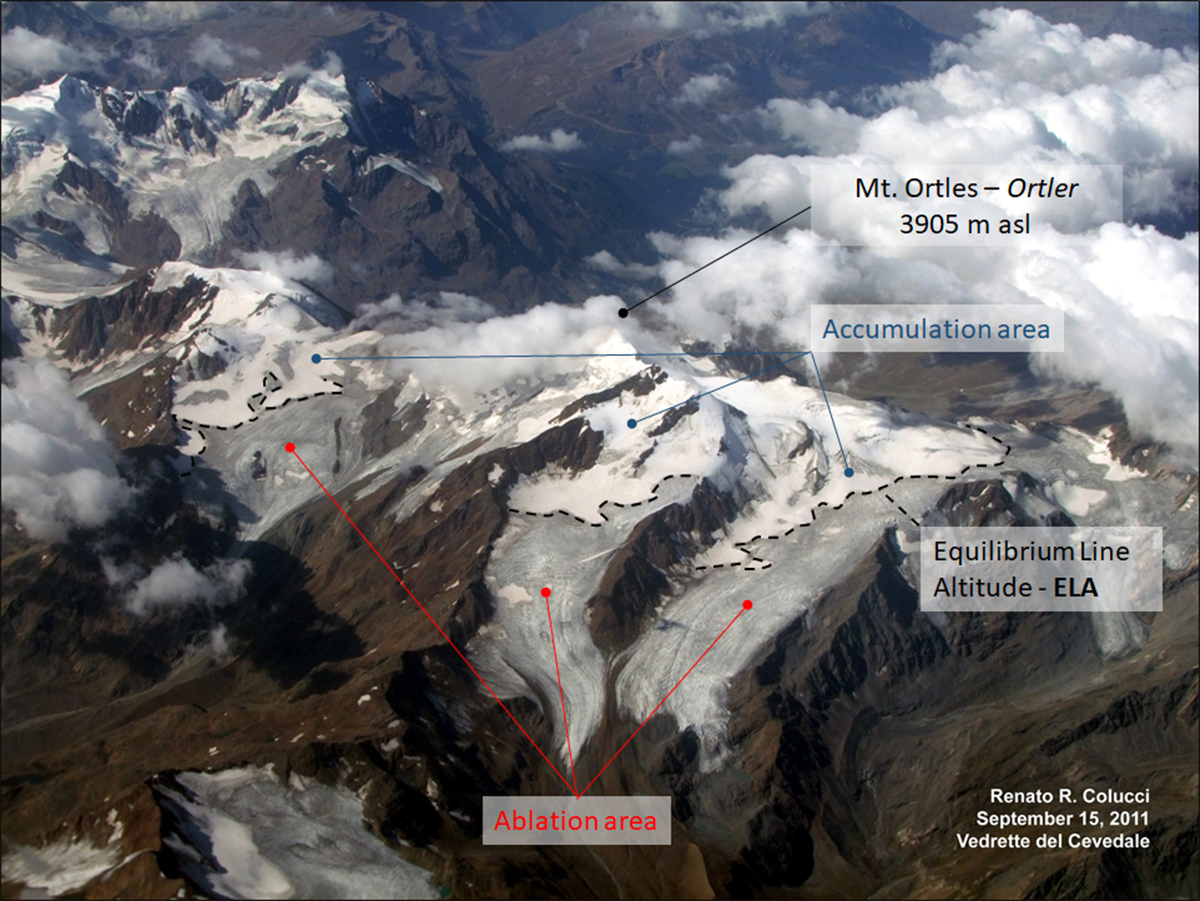
Summer temperature controls ablation processes. Conversely, precipitation rules accumulation processes including snow and ice from direct precipitation, windblown snow, and avalanches. For this reason, a cold dry winter followed by a long hot summer represents the worst-case scenario for glacier’s health. As a matter of fact, the mass balance of a glacier strictly depends on climatic factors, especially summer temperature and winter/annual precipitation.
4396 glaciers currently still exist in the European Alps with a total area of 1806 ± 60 km2. The ELA lies at 3234 m asl averaged over the last v30 years (1991-2020). This means that above this altitude, on average, we are in the accumulation area of alpine glaciers.
But there are places in the Alps where the ELA is much lower. Precipitation is particularly abundant in the southeastern sectors, especially in the Julian Alps spreading west-east between Italy and Slovenia. Here, Mean Annual Precipitation is greater than 3000 mm of water equivalent. This means that every year each square meter of the surface of this alpine sector can expect more than 3000 liters of water and melted snow.

GLACIERS EVOLUTION IN THE JULIAN ALPS ALPS FROM THE END OF THE LITTLE ICE AGE
In the easternmost sector of the southern alpine chain, the Julian Alps, several residual very small but still active ice bodies exist. They refer generally to the size category of small mountain glaciers, glacierets, and ice patches. Almost 150 years ago there were 19 main small glaciers covering about 2.4 km2.
The largest glacier was the Canin glacier (Italy), followed by the Zeleni Sneg – Triglav in Slovenia. After the Little Ice Age alpine peak, which occurred between 1630 and ~1850 A.D., these glaciers shrunk by about 84% in area and 96% in volume. The Canin glacier, now split up in several smaller units, reduced from 0.678 km2 to 0.081 km2. The Zeleni Sneg – Triglav glacier from 0.442 km2 to 0.004 km2.
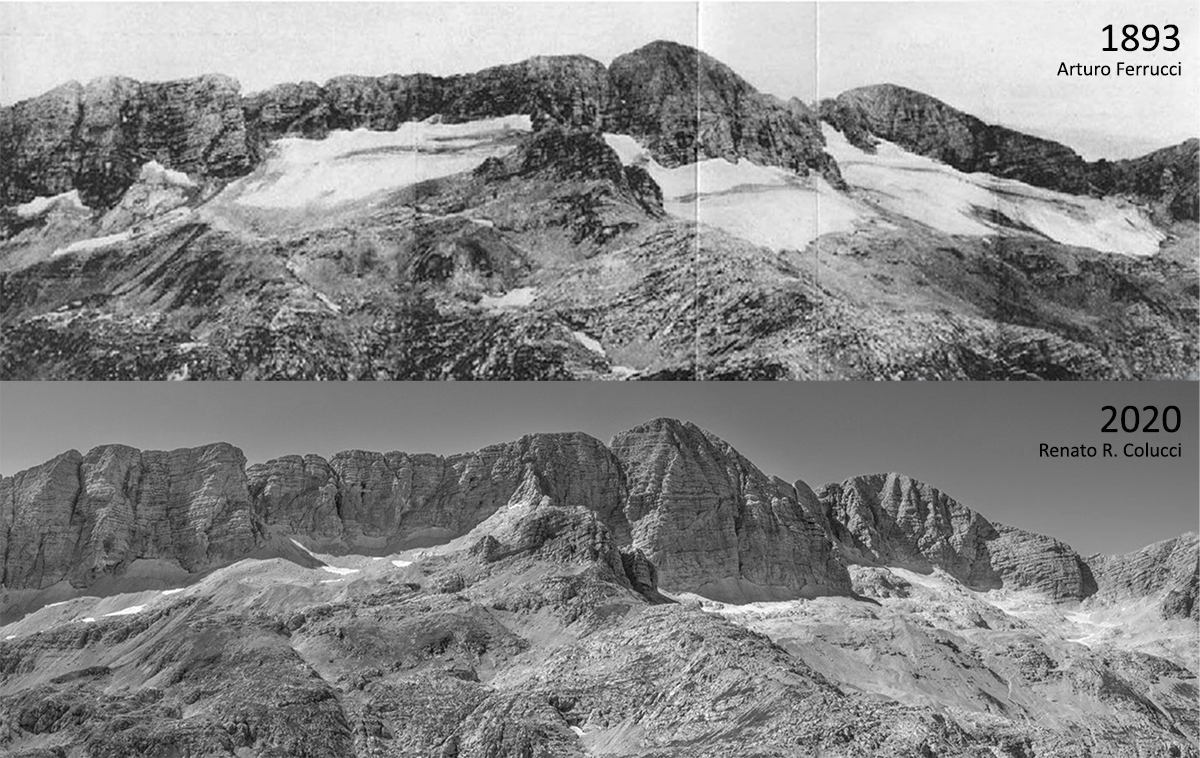
Several old pictures and paintings testify to the massive ice melting. Besides, geomorphological evidence proves the fast retreat the glaciers are undergoing in the Alps after the LIA peak, which is likely unprecedented during the Holocene. The Holocene represents the present geological epoch that started approximately 11650 years before the present at the end of the Younger Dryas cold event, which occurred from 12500 to 11650 years ago.
In the animation below we collected two images from the 1950s of Triglav and Canin glaciers and compare them with the present situation. It is indeed clear as most if not all of the ice from the last century is gone.
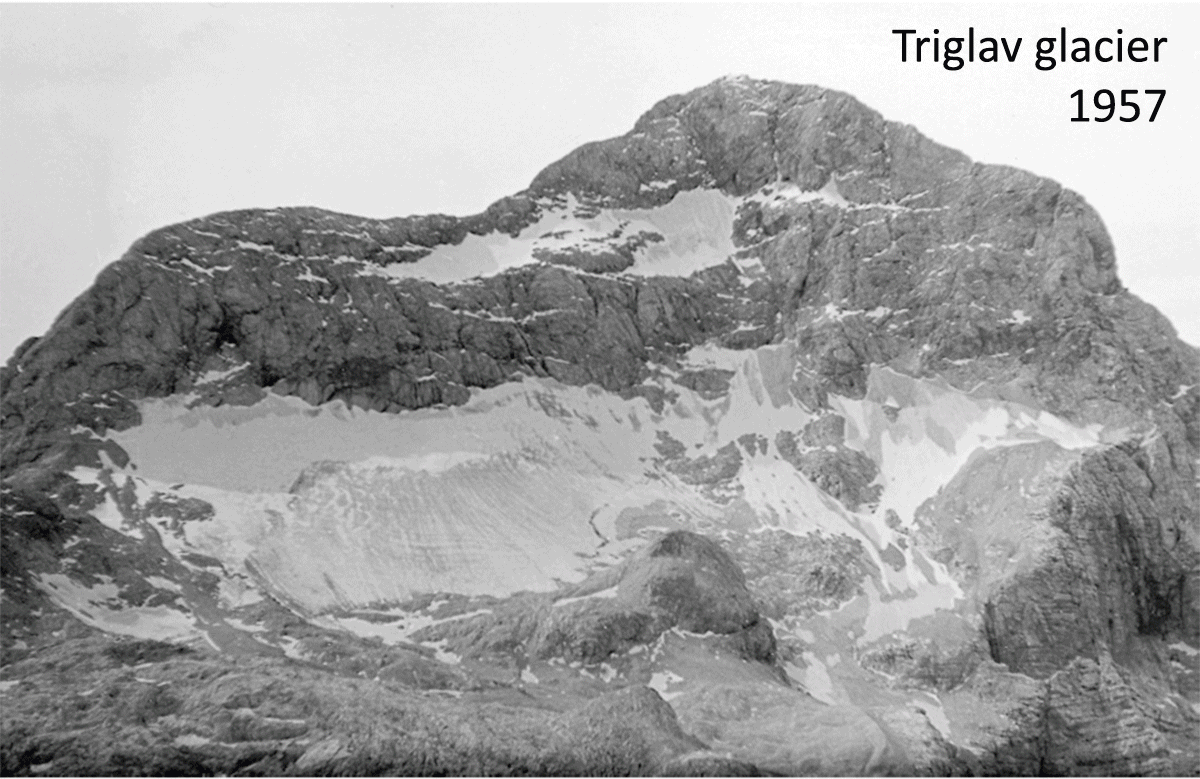
Changes in mean temperature of the ablation season linked to the variability of Atlantic Multidecadal Oscillation (AMO) match well with the long-term evolution of these very small glaciers and ice bodies.
The AMO is a climate index explaining multi-decadal variability of sea surface temperature (SST) in the North Atlantic Ocean from 0 to 70°N. AMO has a cycle of 65–70 years and 0.4°C range between extremes. Accordingly, as one of the most prominent modes of climate variability, AMO also influences Europe’s climate.
In the figure below from this recent study, we show spatial representations and time-series of the AMO. In panel (a) the AMO index 1856–2015; panel (b) shows mean SST anomaly maps (1951–1980 climatology) for warm (left panel) and cool (right panel) years; panel (c) shows average 10-m wind speed during AMO-warm and AMO-cold phase respectively.
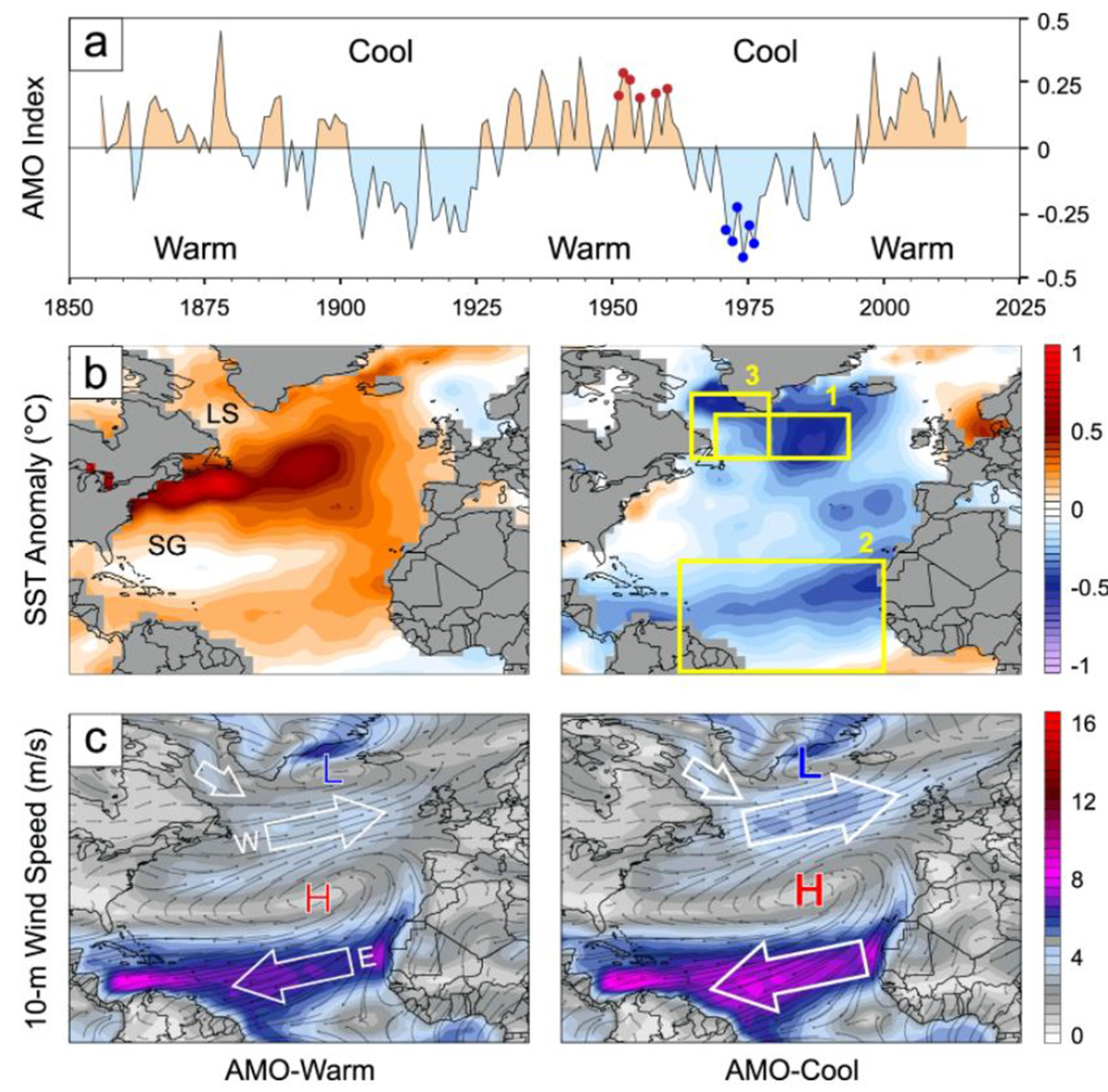
At least over the last 250 years, the size of glaciers in the Alps reacted in response to AMO-driven variations. The effects of Global Warming are now superimposed on it. AMO influences the mass budget of glaciers mainly through minima and maxima in temperature of the ablation season.
The fast and steady increase in mean air temperature of summers from the early 1980s is further superimposed to the AMO. It explains the intense glacier reduction particularly evident after the 1980s. The message here is that the “cyclic” curve is therefore not to be seen regularly developed along a plane but inclined downwards.
To better explain what we are talking about, The figure below from this study shows with the blue line the AMO index from NOAA and with the red line the Canin glacier length variation.
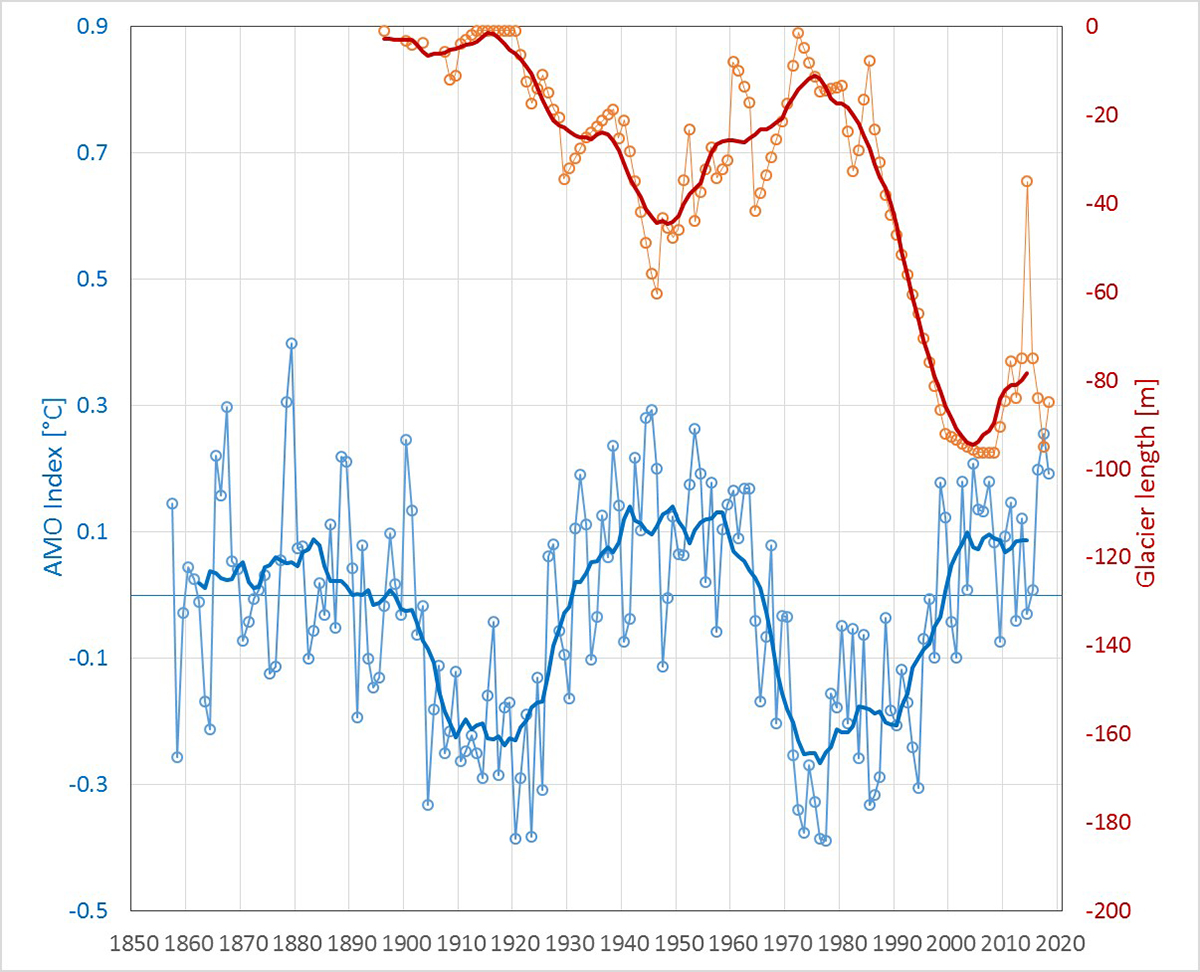
NOW THIS IS BIZARRE! GLACIERS REMAINED STABLE IN THE LAST 15 YEARS IN THE JULIAN ALPS
Small ice bodies in the Julian Alps remained stable in the last 15 years instead of rapidly disappearing, as they should be, due to their smaller size. This happened although summer temperature continued to rise here. According to a recent study, few ice patches rather grew in size with a long-term positive mass balance.
In particular, the residual ice body of the eastern Canin glacier gained 3.53 m of thickness in the period 2006-2018 (see figure below). Converting this value with the density of the mixture of frozen material made by snow, firn, and ice (791 kg per cubic meters), accounts for 2.79 m of water equivalent.
Glaciologists, by using different methodologies including laser scanning, light detection, and ranging, aerial photogrammetry, and geodetic surveys realized how such very small glaciers were able to slightly increase their volume and size.
Few of them simply lounge in a steady-state behavior mocking their larger counterparts in the rest of the Alps. The image below shows the annual elevation change rate for the eastern Canin glacier for individual years (smaller images) and for the 2006 – 2018 period (larger image)
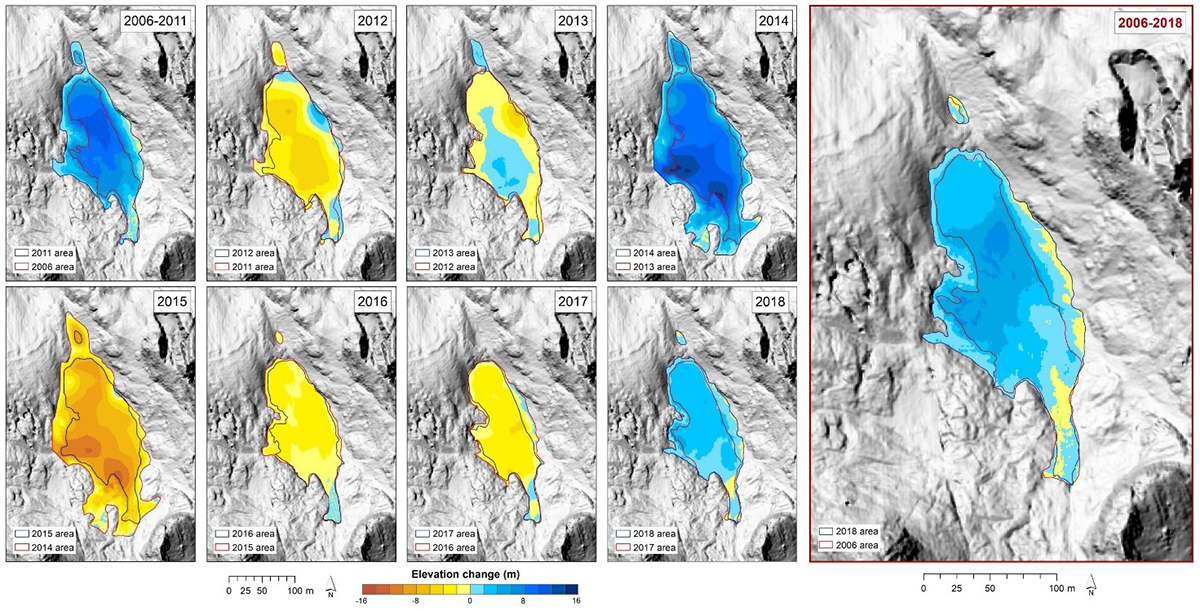 Figure © Atmosphere MDPI Colucci et al. (2021)
Figure © Atmosphere MDPI Colucci et al. (2021)
Also, the Montasio glacier, the only ice body of the Julian Alps that can actually be properly defined as such, undergone a similar fate, a study showed. The Montasio glacier covers an area of 0.066 square kilometers and is known to be the lowermost Italian glacier. Its median elevation is only 1900 m. The glacier is characterized by a steep cone-shaped accumulation area fed by frequent winter avalanches, while a gently sloped surface characterizes the ablation area.
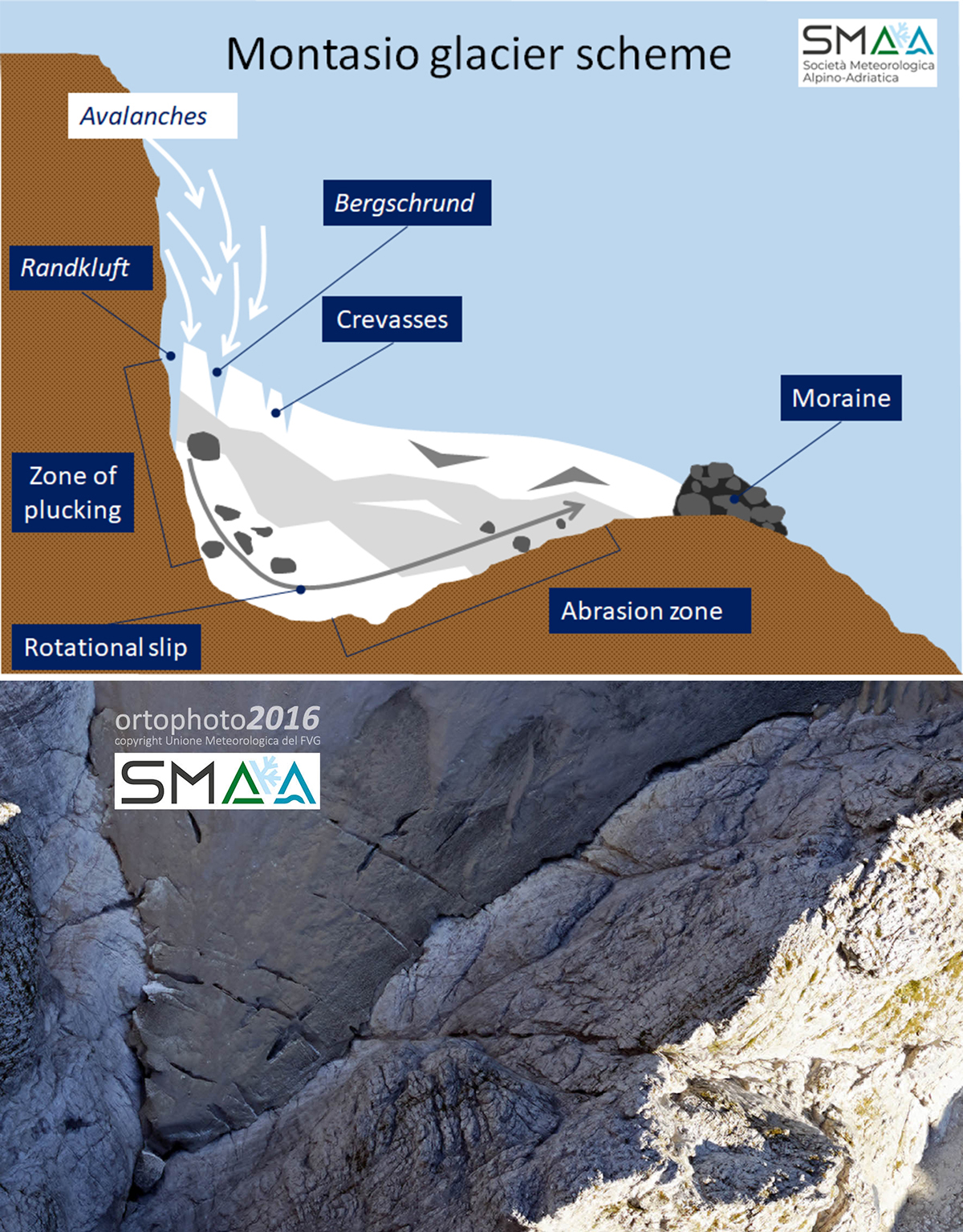
Despite its low altitude, a comparison with a wide sample of Alpine reference glaciers in the period from 2006 to 2019 clearly shows how the Montasio Glacier, as the Canin did, has been much less impacted by the present warm phase, at least until now.
The 2006-2019 mass loss rate of the Montasio Glacier was -0.07 m w.e. per year. This is an order of magnitude lower than the rate of −0.87 ± 0.07 m w.e. per year recently estimated for all the glaciers in the Alps and Pyrenees, in the period from 2006 to 2016.
The image below shows the annual elevation change rate for (a) individual years and (b) two sub-periods. At bottom annual and cumulated geodetic mass balance compared with the average glaciological annual and cumulated balance of nine reference glaciers in the European Alps, in the period from 2006 to 2019.
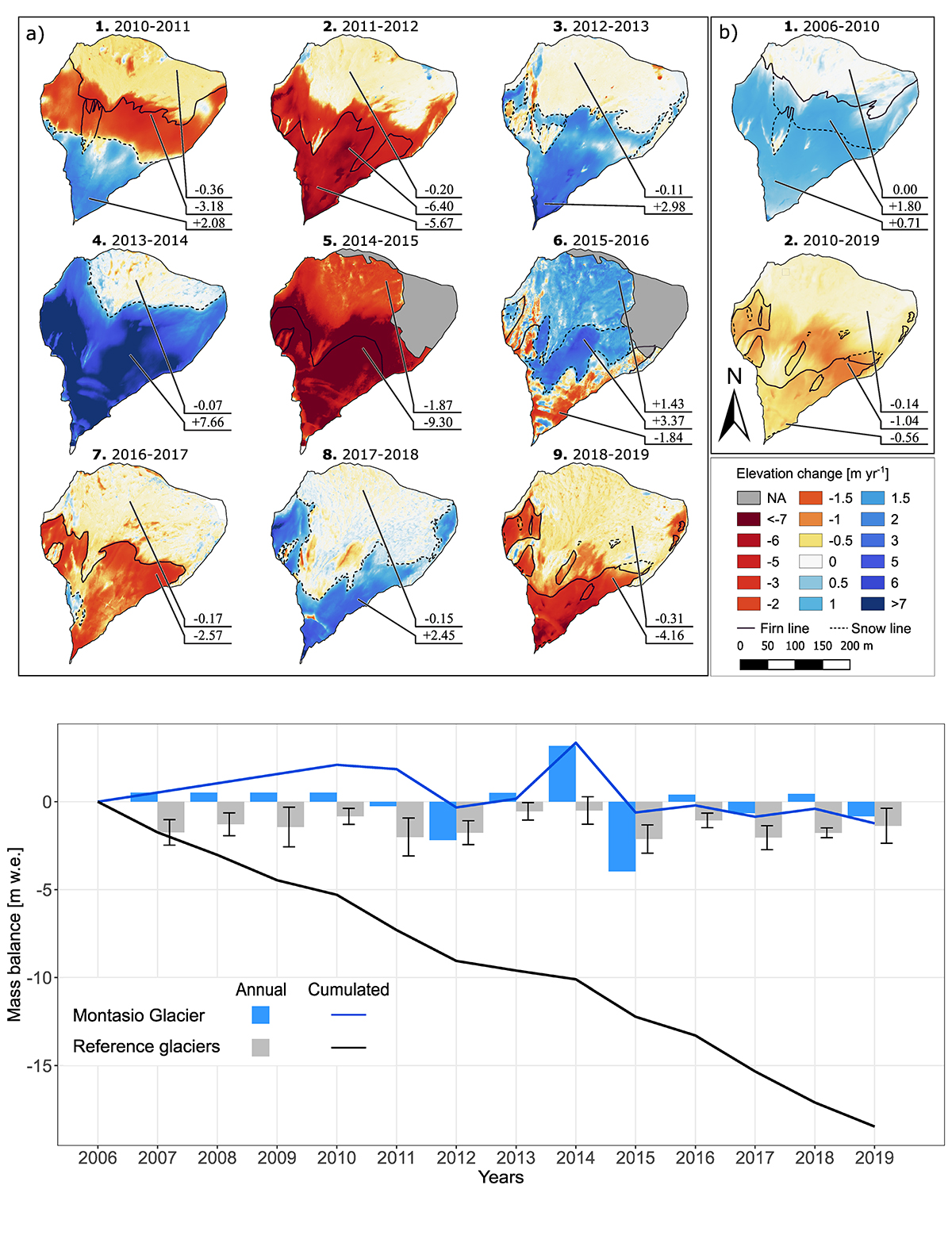
Figure © Water MDPI, De Marco et al. (2021)
SEVERAL YEARS OF POSITIVE MASS BALANCE, BUT WHY IS THIS HAPPENING?
We just argued as in the last three decades summer became longer and warmer in the Alps because the temperature raised constantly. As a matter of fact, the mean annual air temperature above 2000 m in the Julian Alps and in the last 10 years (2010-2020) was 1.5°C higher than the 30-years-climatology 1961-1990, a study shows.
If we look at the 1991-2020 period, we see how the mean annual air temperature was roughly 1.0°C higher than the previous 30 years. In summer this difference is even larger. In fact, the last ten years were 2.3°C warmer than the 1961-1990 climatology. Likewise, 1991-2020 mean summer air temperature was 1.7°C warmer than the previous 30 years.
The figure below shows the annual mean summer air temperature in the Julian Alps at an altitude of 2200 m asl (grey dots). The blue line is a 10-years moving average better highlighting the trend. The abrupt warming starts at the beginning of the 1980s.
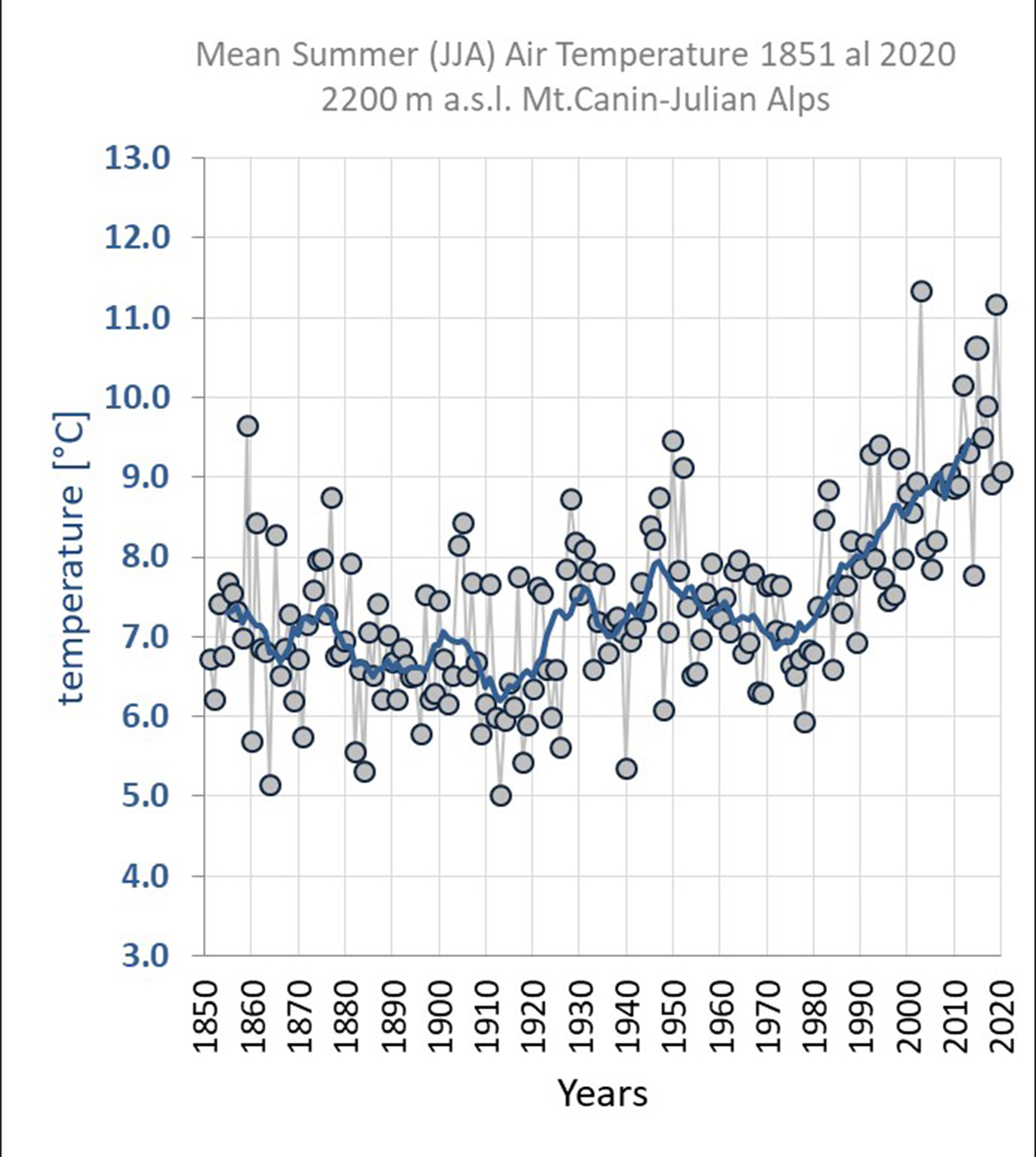
Compared to the past, today more snow and ice melt. Applying a degree-day model for this alpine sector, glaciologists found how the potential melting increased about 29 mm w.e. per year. From roughly 4119 mm w.e. in the late 1970s, in the late 2010s was equal to 5279 mm w.e. per year. You can clearly see this in the figure below where, on the right, we plotted the length in days of the ablation period. From the late 1970s up to now the melting period increased by roughly two weeks.
For statistical purposes only, the less effective ablation seasons were summer 1984 and 1996 with 3446 and 3621 mm w.e., respectively. The most effective ablation seasons were summer 2003 and 2012 with 5747 and 5755 mm w.e., respectively. Summer 2003 recorded the highest temperature for a shorter period. The 2012 ablation period lasted longer but was less extreme in terms of absolute values. Recent positive mass balance cannot thus be attributed to favorable temperature!
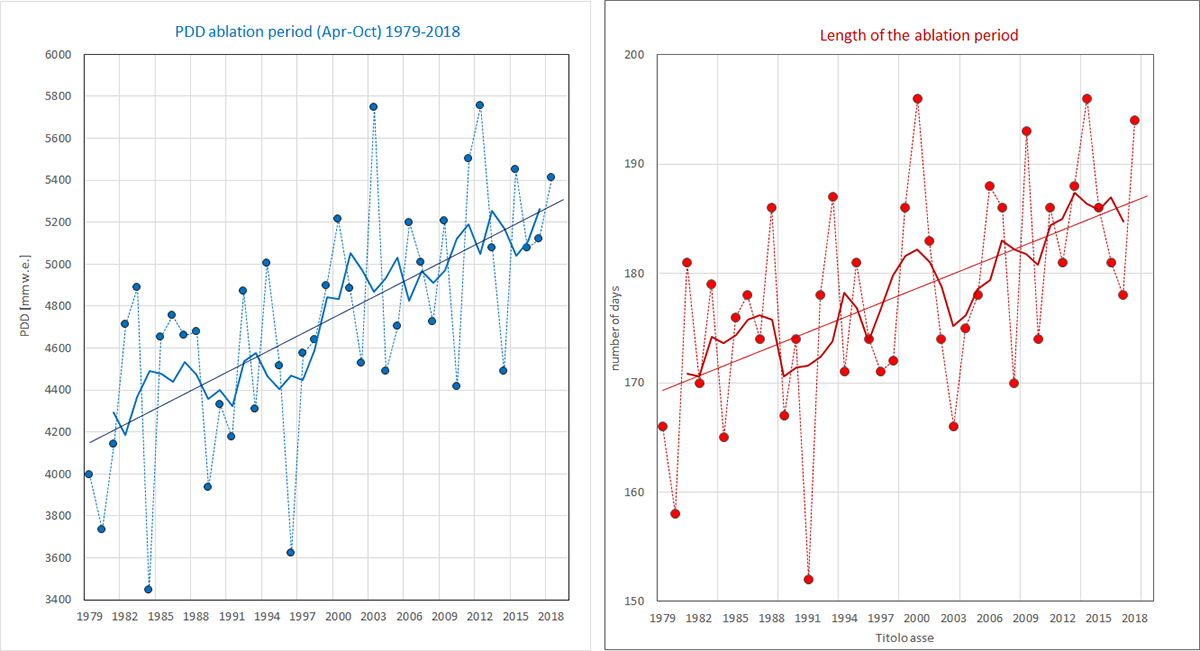
HERE IS THE ANSWER: HIGHER FREQUENCY OF EXTREMELY SNOWY WINTERS
The recent increase in winter precipitation and few seasonal winter extremes brought much higher than average snowfalls over residual ice bodies of the Julian Alps. In the image below we show winter precipitation and snow total accumulation for the period 1979-2018.
From 2006 to 2018 this excess in precipitation led to ice bodies stability and overall a positive mass balance. New bare ice outcropped over the surface of several ice patches. This proves a long-term trend of ice accretion in this small, but peculiar alpine area between Italy and Slovenia.
In the central-southern range of the Alps, two small cirque glaciers in the Orobic chain also reported the occurrence of particularly snowy winters in 2008–2009 and 2013–2014 according to recent research. This excess of snow provided accumulation for perennial ice patches able to survive very warm summers. This area indeed shares several common features with the Julian Alps especially in terms of orographic precipitation.

SO WHY JULIAN ALPS ARE CATCHING MORE SNOW LATELY?
First, local topographical factors help larger accumulation from avalanches. Nevertheless, the most relevant cause seems linked to extreme precipitation events induced by recent warming. But the real cause of such changes might be located far from the Alps.
In the past few decades, Arctic warming was almost doubled compared with the entire northern hemisphere. A combination of positive feedback and increased anthropogenic global warming lead to the so-called Arctic Amplification (AA).
Observations and modeling recognized several large-scale modifications in the atmospheric circulation. These changes lead to earlier snowmelt and sea-ice loss, which in turn affect precipitation, seasonal temperatures, storm tracks, and surface winds in the mid-latitudes.
The panel below explains all the processes involved in the AA.
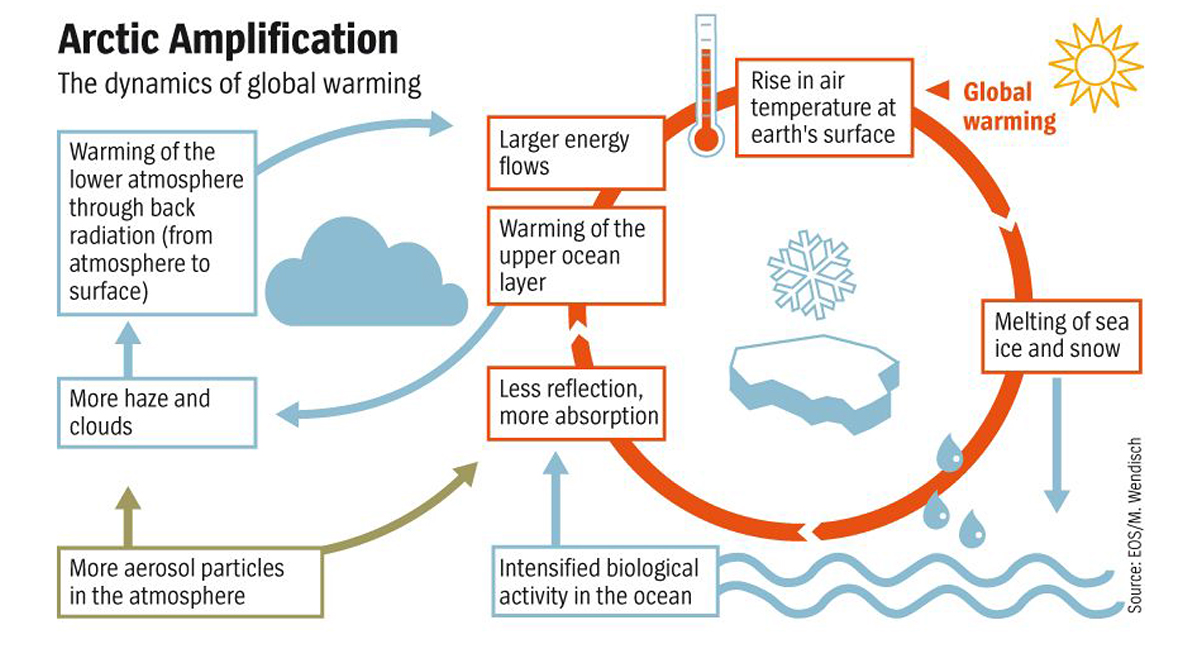
Singular strong weather events normally have a dynamical origin and many of them result from persistent weather patterns, typically associated with blocking and high amplitude waves in the upper-level flow. Evidence links the Arctic Amplification with an increased tendency for a slower eastward movement of Rossby Waves. This in turn favors weather extremes triggered by persistent weather conditions due to amplified flow trajectories.
Rossby waves, also known as planetary waves, naturally occur in rotating fluids. These waves, within the Earth’s ocean and atmosphere, form as a result of the rotation of the planet and give birth to the typical meandering of the global atmospheric circulation.
The process leading to an increased meandering and slow-down of the Rossby Waves is known as Quasi Resonant Amplification (QRA), briefly explained below in the figure.

Coming to the end, we can summarize by saying that recently recorded extreme and prolonged winter snowfalls were sufficient to offset longer and warmer summers in this alpine sector. Such extreme seasonal events were also favored by increased Sea Surface Temperature and the thermodynamic structure of the low troposphere.
In fact, a recent study shows as the sea surface temperature of the northern Mediterranean is less than one century increased by about 1.3°C.
More, evidence links the occurrence of amplified upper-level flow trajectories to the Arctic Amplification and, therefore, to ongoing global warming. Modification of weather patterns due to a set of teleconnections and higher occurrence of extreme and persistent snowfall events in winter might represent a crucial input in the survival of small glacial remnants in maritime mountain areas, although further summer warming is expected in the next decades.
But snow is turning into rain every year higher in the mountains because winter temperatures are also increasing. This might be even more crucial in the next future.
See also: